Profile Management
Display the profiles you have or the profiles in a group when selecting a group. You can perform various actions with these profiles.
Each profile is akin to a separate machine, distinct from any other.
New Profile
Create a new profile.
Add
Add a profile with the following parameters:
Profile Name: The name of the profile. Leave blank to generate a random name.
Group: The group to store the profile being created. Default is
Default group.URLs to Open: URLs that will open when the profile is launched.
Proxy: Proxy to change the IP for the profile. If the proxy is dead, the profile cannot be opened.
Browser Kernel: Chrome version. It is recommended to use the latest version.
OS: Operating system for the profile.
Browser: After selecting a browser type, you can configure different versions of that browser. By default, the latest version is selected.
Timezone: Enable to set timezone based on IP; disable to use your real timezone.
Location: Enable to set geographic location based on IP; disable to allow websites to retrieve location based on manually entered values.
- Latitude and Longitude determine a specific geographic location on Earth.
- Accuracy (m) indicates the location’s precision — e.g., 15 meters means the actual location is within a 15-meter radius around the coordinates.
WebRTC: Allows peer-to-peer (P2P) browser communication, used for video calls, file sharing, etc. Options include:
- Automatic: WebRTC enabled. Public IP is replaced by proxy IP, and local IP is hidden.
- Disable STUN: WebRTC enabled. All STUN servers are blocked. Public IP is replaced by proxy IP, and local IP is hidden.
- Manual: WebRTC enabled. Public IP is replaced by the IP, you specify, and local IP is hidden.
- Real: WebRTC enabled. My real IP address is used.
- Disabled: WebRTC is disabled. Websites may detect that WebRTC is turned off.
Screen Resolution: Size of the profile, defaults to the computer’s resolution.
Language: Browser language.
- Automatic: Selects a random language for the profile.
- Unchanged: Uses the computer’s language.
- Custom: Sets a desired language.
Fonts: Browser fonts.
- Custom: Randomly selects from a list.
- System Default: Uses fonts similar to those on your computer.
Canvas: Part of HTML5, allows drawing 2D graphics directly in the browser via JavaScript.
- Noise: Sets different Canvas for configurations on the same device.
- Deep Noise: This mode is suitable for small websites with fewer visitors, mainly not e-commerce or social media platforms.
- Close: Each Browser Profile uses the computer’s default Canvas.
WebGL Image: Images or textures rendered by WebGL — 3D graphics in the browser using GPU.
- Noise: Sets different WebGL for configurations on the same device.
- Close: Each Browser Profile uses the computer’s default WebGL.
WebGL Metadata: Supplementary WebGL information, such as GPU model, vendor, shader precision, etc.
- Custom: Sets a value to replace the device’s real WebGL Metadata.
- Close: Each Browser Profile uses the computer’s default WebGL.
Audio Context: Enables advanced audio processing in the browser, such as mixing music, creating effects, or analyzing sound.
- Custom: Sets different Audio Fingerprints for profiles on the same device.
- Close: Each browser profile uses the computer’s default Audio.
ClientRects: JavaScript API to retrieve size and position information of HTML elements (bounding boxes).
- Noise: Creates different ClientRects for each profile on the same computer.
- Close: Each profile uses the computer’s default ClientRects.
Mask Media Devices: Relates to hiding or limiting information about media devices (camera, microphone, speakers) provided by the browser. Used for privacy protection — e.g., some extensions or privacy modes may “mask” information like the microphone in use.
Bluetooth: turn on/off bluetooth used on the web If you need to use a webcam or microphone, you must disable this feature.
Fast Create
Quantity: Enter the number of profiles to create, ranging from 1 to 100. Name, account, password, and cookies are empty.
Group: The group to store the profiles being created. Default is
Default group.Proxy: Proxy to change IP for all profiles to be created. If the proxy is dead, the profiles cannot be opened.
Browser Kernel: Chrome version. It is recommended to use the latest version.
OS: Operating system for the profile.
Browser: After selecting a browser type, you can configure different versions of that browser. Select
Allto randomly assign a version to each profile. Select one version for all profiles to use that version; select multiple versions for each profile to use one of the selected versions.Timezone: Enable to set timezone based on IP; disable to use your real timezone.
Location: Enable to set geographic location based on IP; disable to allow websites to retrieve location based on manually entered values.
- Latitude and Longitude determine a specific geographic location on Earth.
- Accuracy (m) indicates the location’s precision — e.g., 15 meters means the actual location is within a 15-meter radius around the coordinates.
WebRTC: Allows peer-to-peer (P2P) browser communication, used for video calls, file sharing, etc. Options include:
- Automatic: WebRTC enabled. Public IP is replaced by proxy IP, and local IP is hidden.
- Disable STUN: WebRTC enabled. All STUN servers are blocked. Public IP is replaced by proxy IP, and local IP is hidden.
- Manual: WebRTC enabled. Public IP is replaced by the IP, you specify, and local IP is hidden.
- Real: WebRTC enabled. My real IP address is used.
- Disabled: WebRTC is disabled. Websites may detect that WebRTC is turned off.
Screen Resolution: Size of the profile, defaults to the computer’s resolution.
Language: Browser language.
- Automatic: Selects a random language for the profile.
- Unchanged: Uses the computer’s language.
- Custom: Sets a desired language.
Fonts: Browser fonts.
- Custom: Randomly selects from a list.
- System Default: Uses fonts similar to those on your computer.
Canvas: Part of HTML5, allows drawing 2D graphics directly in the browser via JavaScript.
- Noise: Sets different Canvas for configurations on the same device.
- Close: Each Browser Profile uses the computer’s default Canvas.
WebGL Image: Images or textures rendered by WebGL — 3D graphics in the browser using GPU.
- Noise: Sets different WebGL for configurations on the same device.
- Close: Each Browser Profile uses the computer’s default WebGL.
WebGL Metadata: Supplementary WebGL information, such as GPU model, vendor, shader precision, etc.
- Custom: Sets a value to replace the device’s real WebGL Metadata.
- Close: Each Browser Profile uses the computer’s default WebGL.
Audio Context: Enables advanced audio processing in the browser, such as mixing music, creating effects, or analyzing sound.
- Custom: Sets different Audio Fingerprints for profiles on the same device.
- Close: Each browser profile uses the computer’s default Audio.
ClientRects: JavaScript API to retrieve size and position information of HTML elements (bounding boxes).
- Noise: Creates different ClientRects for each profile on the same computer.
- Close: Each profile uses the computer’s default ClientRects.
Mask Media Devices: Relates to hiding or limiting information about media devices (camera, microphone, speakers) provided by the browser. Used for privacy protection — e.g., some extensions or privacy modes may “mask” information like the microphone in use.
If you need to use a webcam or microphone, you must disable this feature.
Import Excel
Import an Excel file exported using the Export function in the OmniLogin app.
Group: The group to store the profiles being created. Default is
Default group.Import: Drag or select to open the file list on the computer. Multiple files can be imported here.
Browser Kernel: Chrome version. It is recommended to use the latest version.
OS: Operating system for the profile.
Browser: After selecting a browser type, you can configure different versions of that browser. Select
Allto randomly assign a version to each profile. Select one version for all profiles to use that version; select multiple versions for each profile to use one of the selected versions.Timezone: Enable to set timezone based on IP; disable to use your real timezone.
Location: Enable to set geographic location based on IP; disable to allow websites to retrieve location based on manually entered values.
- Latitude and Longitude determine a specific geographic location on Earth.
- Accuracy (m) indicates the location’s precision — e.g., 15 meters means the actual location is within a 15-meter radius around the coordinates.
WebRTC: Allows peer-to-peer (P2P) browser communication, used for video calls, file sharing, etc. Options include:
- Automatic: WebRTC enabled. Public IP is replaced by proxy IP, and local IP is hidden.
- Disable STUN: WebRTC enabled. All STUN servers are blocked. Public IP is replaced by proxy IP, and local IP is hidden.
- Manual: WebRTC enabled. Public IP is replaced by the IP, you specify, and local IP is hidden.
- Real: WebRTC enabled. My real IP address is used.
- Disabled: WebRTC is disabled. Websites may detect that WebRTC is turned off.
Screen Resolution: Size of the profile, defaults to the computer’s resolution.
Language: Browser language.
- Automatic: Selects a random language for the profile.
- Unchanged: Uses the computer’s language.
- Custom: Sets a desired language.
Fonts: Browser fonts.
- Custom: Randomly selects from a list.
- System Default: Uses fonts similar to those on your computer.
Canvas: Part of HTML5, allows drawing 2D graphics directly in the browser via JavaScript.
- Noise: Sets different Canvas for configurations on the same device.
- Close: Each Browser Profile uses the computer’s default Canvas.
WebGL Image: Images or textures rendered by WebGL — 3D graphics in the browser using GPU.
- Noise: Sets different WebGL for configurations on the same device.
- Close: Each Browser Profile uses the computer’s default WebGL.
WebGL Metadata: Supplementary WebGL information, such as GPU model, vendor, shader precision, etc.
- Custom: Sets a value to replace the device’s real WebGL Metadata.
- Close: Each Browser Profile uses the computer’s default WebGL.
Audio Context: Enables advanced audio processing in the browser, such as mixing music, creating effects, or analyzing sound.
- Custom: Sets different Audio Fingerprints for profiles on the same device.
- Close: Each browser profile uses the computer’s default Audio.
ClientRects: JavaScript API to retrieve size and position information of HTML elements (bounding boxes).
- Noise: Creates different ClientRects for each profile on the same computer.
- Close: Each profile uses the computer’s default ClientRects.
Mask Media Devices: Relates to hiding or limiting information about media devices (camera, microphone, speakers) provided by the browser. Used for privacy protection — e.g., some extensions or privacy modes may “mask” information like the microphone in use.
If you need to use a webcam or microphone, you must disable this feature.
Below is how to import an Excel file to create profiles with data from that file:
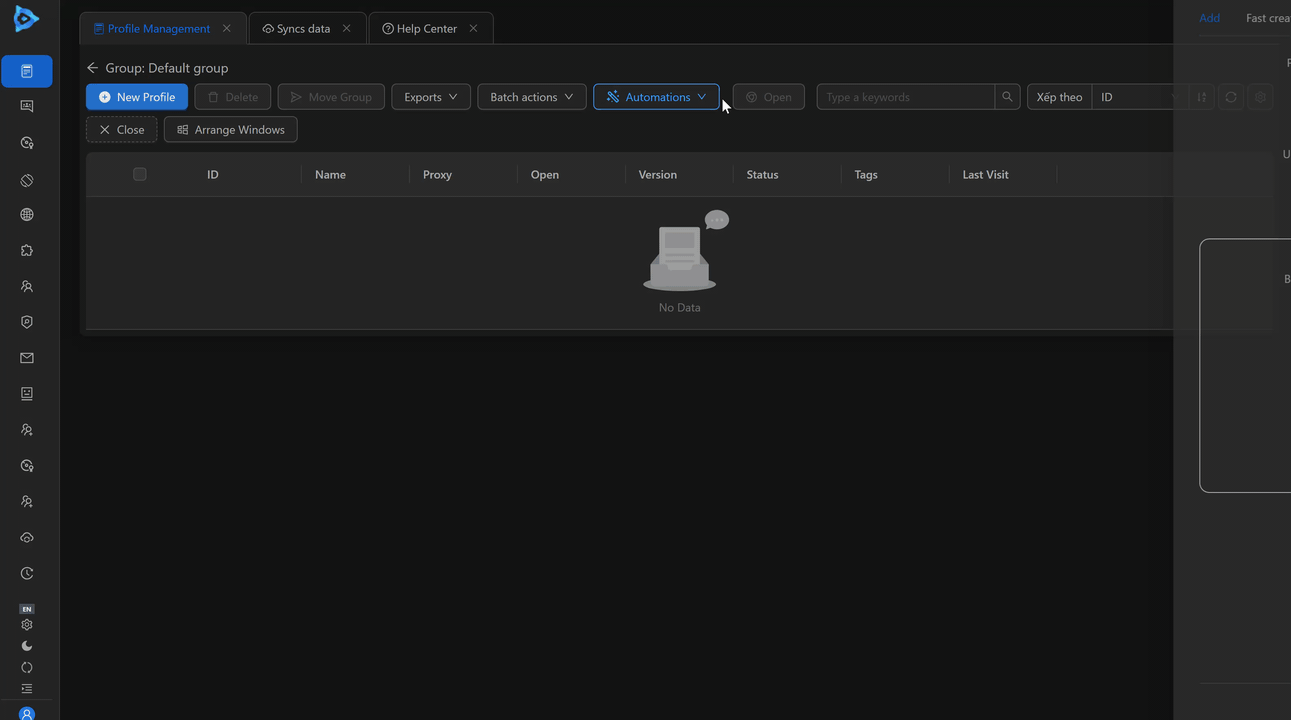
Import Profiles Data
Import a data file exported from the Export function of the OmniLogin app.
- Group: The group to store the profiles being created. Default is
Default group. - Password: Password for the data file, if applicable.
- Import: Drag the file or select it from the computer here.
Below is how to import a profiles data file to create profiles with data from that file:

Delete
- When selecting profiles, you can use this feature to delete the selected profiles. When deleting, you can choose to delete both the profile and its data or only delete the profile from the app while keeping the data on the computer.

If you accidentally delete a profile but haven’t deleted its data, follow this guide.
Move Group
After selecting profiles, you can move them to another group. This function is only available to the main account.
Export
Export Excel 1000 Latest Records
Export records of the 1000 most recent profiles. The file will be an Excel file with columns as follows:

Export Excel Selected Records
Export records of the selected profiles. The file will be an Excel file with columns as follows:

Export Profiles Data Selected
Export data of the selected profiles. You can choose to include: Profile Name, Proxy, URLs to Open, Extensions.
Export Data Path: Configure the location to save the data file. By default, it saves to Downloads\OmniLogin\Exported-Profiles on drive C.
Password: Password for the file, optional.
Batch actions
Update Tags
Update tags for the selected profiles. Update methods include:
- Append to List: Add selected tags to the end of the list.
- Replace All Old Tags: Delete all tags of the selected profiles and add new ones (completely replace the old list).
- Delete All Tags: Remove all tags.
Note
A profile can contain a maximum of 10 tags.
Update URLs to Open
Update URLs to Open when launching profiles.
Update Proxy
Update proxies for profiles.
- One for All: Update one proxy for all profiles.
- Sequential for Each Profile: Update a list of proxies for the list of profiles in order. The proxy list must match the profile list.
Quick Proxy Check
Check if proxies are still usable. After checking, active proxies will turn green, and inactive ones will turn red.
Enable/Disable Proxy
Choose to enable or disable proxies for the profiles.
Clear Profile Cache
Clear cache for the profiles.
Clean Profile
Remove errors and abnormal junk data to restore profiles to their optimal state.
Backup to Cloud
Back up the current data of selected profiles to Google Drive. To use this function, log in to the Data Sync feature.
Enable Sync
Sync profile data to the cloud. When using this feature, the profile’s data will be accessible on other computers. To use this function, log in to the Data Sync feature.
Disable Sync
Disable data syncing for the profile. When disabled, opening the same profile on different computers will show different data.
Force Unlock Profile
Force unlock a profile currently opened by another member.
Copy Profile ID
Copy the IDs of the selected profiles.
Update Profile Name
Method
Automatic
- Configuration
- Configure using the expression
{current name}{number from 1}{today}. For example, to configure with the nameomni,number starting from 1,date as today, separated by-, configure asomni-{number from 1}-{today}. The result will be:omni-1-07/07/2025. The second profile will beomni-2-07/07/2025. - Name List: List of new names for profiles created based on the expression.
- Configure using the expression

Manual
- Configuration: Rename each profile to the desired name.
- Name List: Select profiles from the list to rename. Each name on a new line, with the number of lines equal to the number of selected profiles.
Update to Latest Chrome
Update to the latest Chrome version installed for all selected profiles. To check if the latest Chrome version is available, follow these steps:
First, click the circular arrows icon at the bottom left of the app.

Then, select options 1 and 2 to check for new versions.
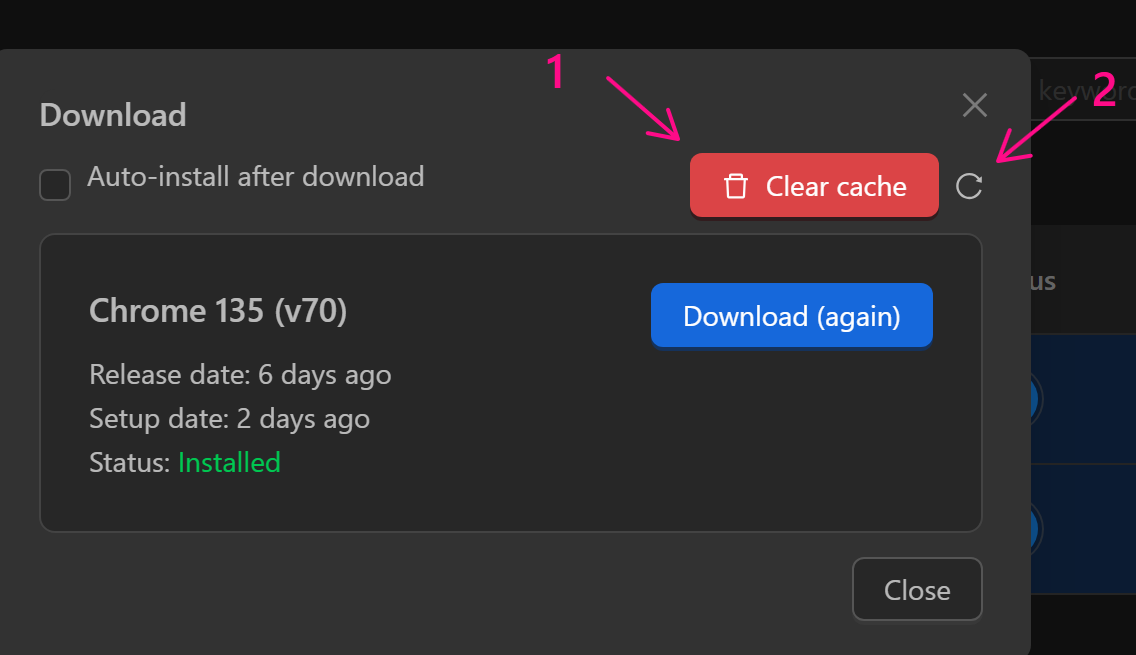
If available, select Download.
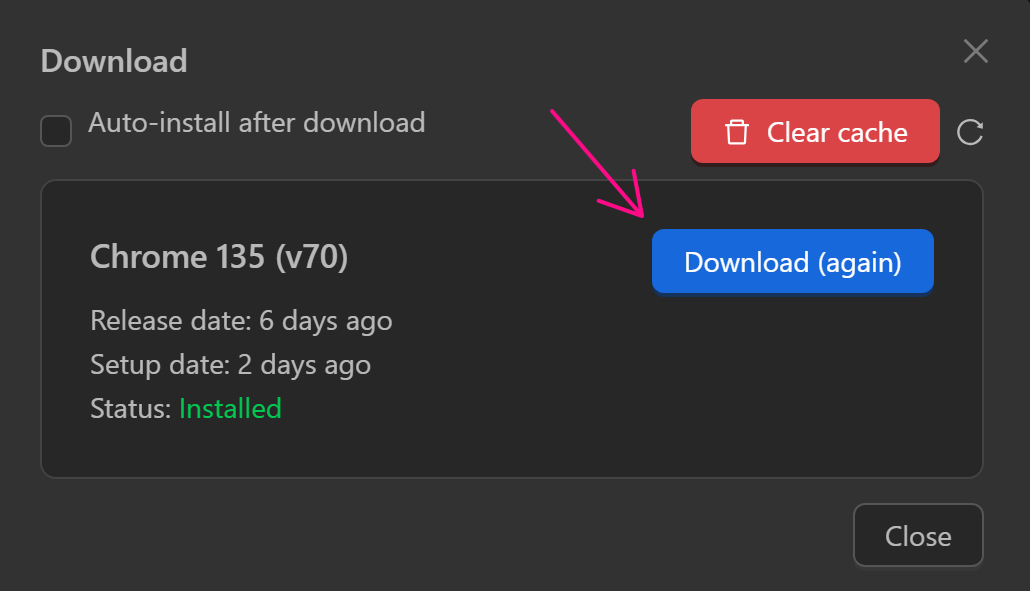
Then, select Install.

This downloads the latest Chrome version, allowing use of this function to update profiles to that version. To check which Chrome version a profile is using, look at the Version column in the profile.

Automation
Auto Login
Automatically log in accounts to platforms.
- Domain: Name of the platform to log in to (Gmail, Facebook, Discord, Twitter, Outlook, Telegram).
- Delimiter: Separates data fields in a line. For example, for data in the format user|pass, enter
|. - Fast Mode: Fast mode skips human-like interactions. For platforms with strict checks, avoid enabling this mode.
- Wait Time: Wait time between opening profiles (seconds).
- Concurrent Profiles: Number of profiles running simultaneously during login.
- Accounts: List of accounts. One account per line. Maximum 100 accounts, and the number of accounts must equal the number of selected profiles.
- Supported Formats: Formats corresponding to the domain.
Multi-Window Sync (New)
Window Control
- Select Screen: Choose screens to display profiles for syncing.
- Select Main Profile: Choose the main profile to control secondary profiles.
- Rest When Opening Profile (s): Wait time for each profile opening. Avoid setting to 0 to prevent action sync failures.
- Main Window on Separate Screen: The main profile displays on one screen. This option appears only when selecting two screens.
- Window Click Delay (s): When enabled, secondary windows execute after the main window with a random delay between Min and Max.
- Window Ratio (%): Ratio of main and secondary windows.
- Window Size (px)
- Auto Divide Equally: Automatically divides windows for profiles based on quantity and selected ratio.
- Fixed Size: Fixes profile size when opening. With this option, windows may overlap when opening many.
- Grid Layout: Choose the number of columns and rows to display the desired number of synced profiles.
- Auto Open and Arrange Profiles: When profiles are not open, use this mode to open and arrange them. When disabled, action sync only controls already open profiles without opening closed ones.
- Show Virtual Mouse Cursor: Not recommended. Some websites may detect a virtual mouse as abnormal.
- Sync Actions: Click here to perform synchronized actions across profiles.
- Arrange Windows: Re-arrange windows if the initial arrangement is messy.
- Show Main Window: The main window will be displayed.
Auto Fill Data
- Show Table Data: Display data in the table. If disabled, all characters are replaced with
*. - Sync Actions: Click here to perform synchronized actions across profiles.
- Auto Fill (Ctrl+[1-9]): Automatically fill selected values from the table data for all profiles simultaneously.
- Batch Paste (Ctrl + Alt+[1-9]): Fill values sequentially for each profile.
For example, you have the following data:

When using the Auto Fill function, it operates as follows:
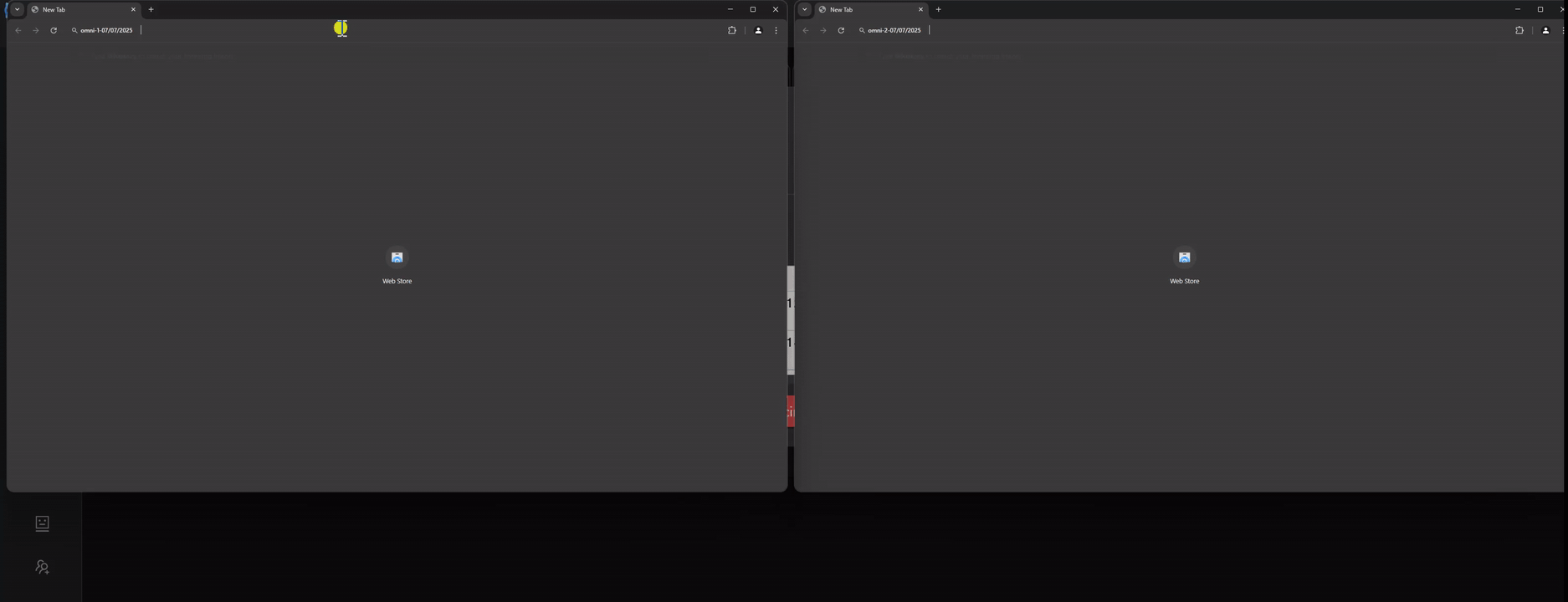
When using the Paste batch function, it operates as follows:
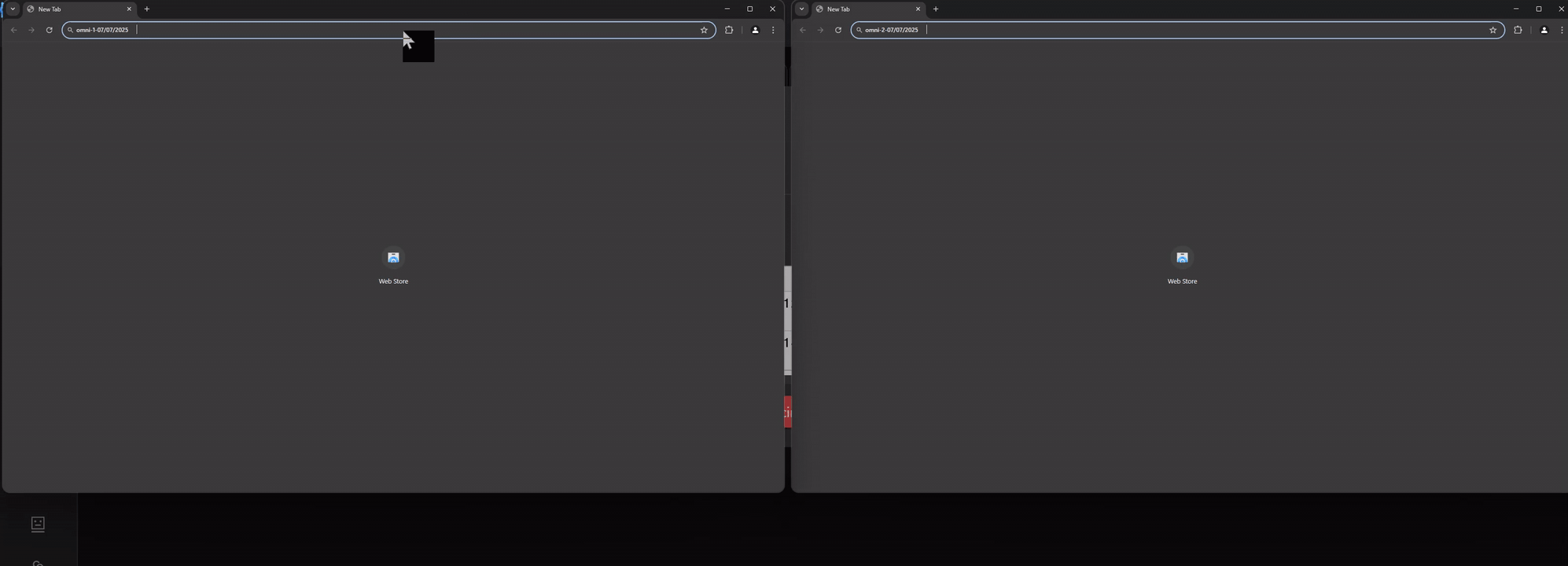
Example of using the Windows Multi-Control feature when logging into an X account
In case you want to use synchronization to log into an X account, you need to configure it as follows: First, fill in the username, password, and 2fa data of the account into the three respective columns in the Auto-fill data section. In the third column, add otp: before the 2fa value. This addition will help convert the 2fa into a code when filling in the data for login, instead of entering the 2fa into a third-party service to obtain the code.

Then, when synchronizing, the value in the 2fa column will be filled into the login field for the account.

Note
The time on the user's device must match the actual time for 2fa to generate the correct code.
Action Sync (Old)
Status
Status of the action sync function.
- Off: Action sync function is not in use.
- On: Action sync function is in use.
Show Table Data
Enable this to display table data. If disabled, data is shown as *.
Window Size (px)
Select profile window size by Width (horizontal) and Height (vertical).
Window Ratio (%)
Select the ratio of the main window to secondary windows.
Open on Startup
URLs to Open when launching the profile. Leave blank to open no additional pages.
Rest When Opening Profile (s)
Time between opening each profile.
Window Offset (px)
Distance between the first and second profiles.
To clarify, demonstrate two cases with different offset lengths:
- Case with
horizontaloffset of500pxandverticaloffset of100px:


- Case with
horizontaloffset of500pxandverticaloffset of500px:

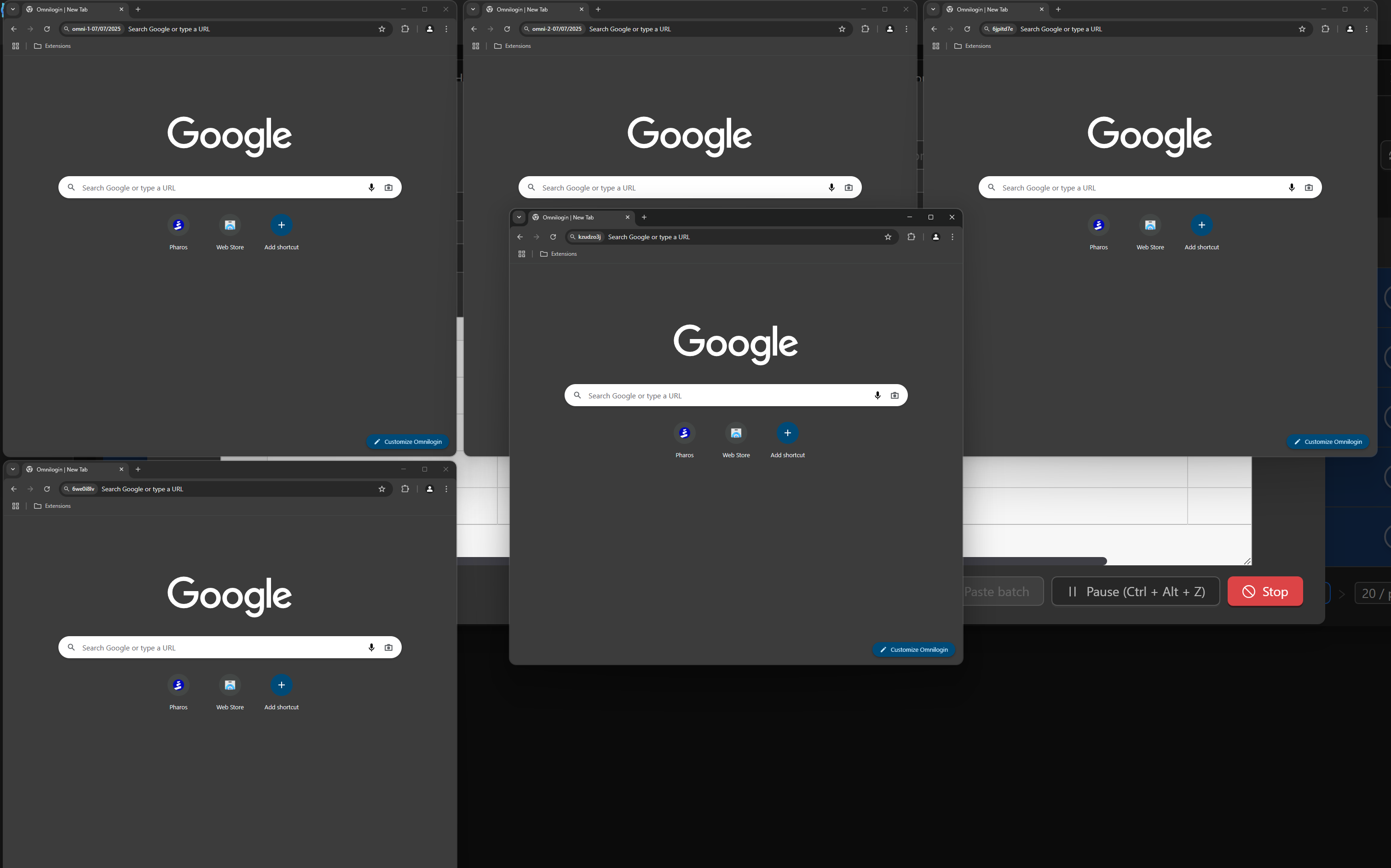
Execute
Execute the action sync function. When clicking this button, profiles will open, and once fully opened, actions can be synchronized across profiles.
Auto Fill
Fill each character of the selected data simultaneously across profiles.
For example, selected this data column:

When using the Auto Fill feature, values are filled as follows:
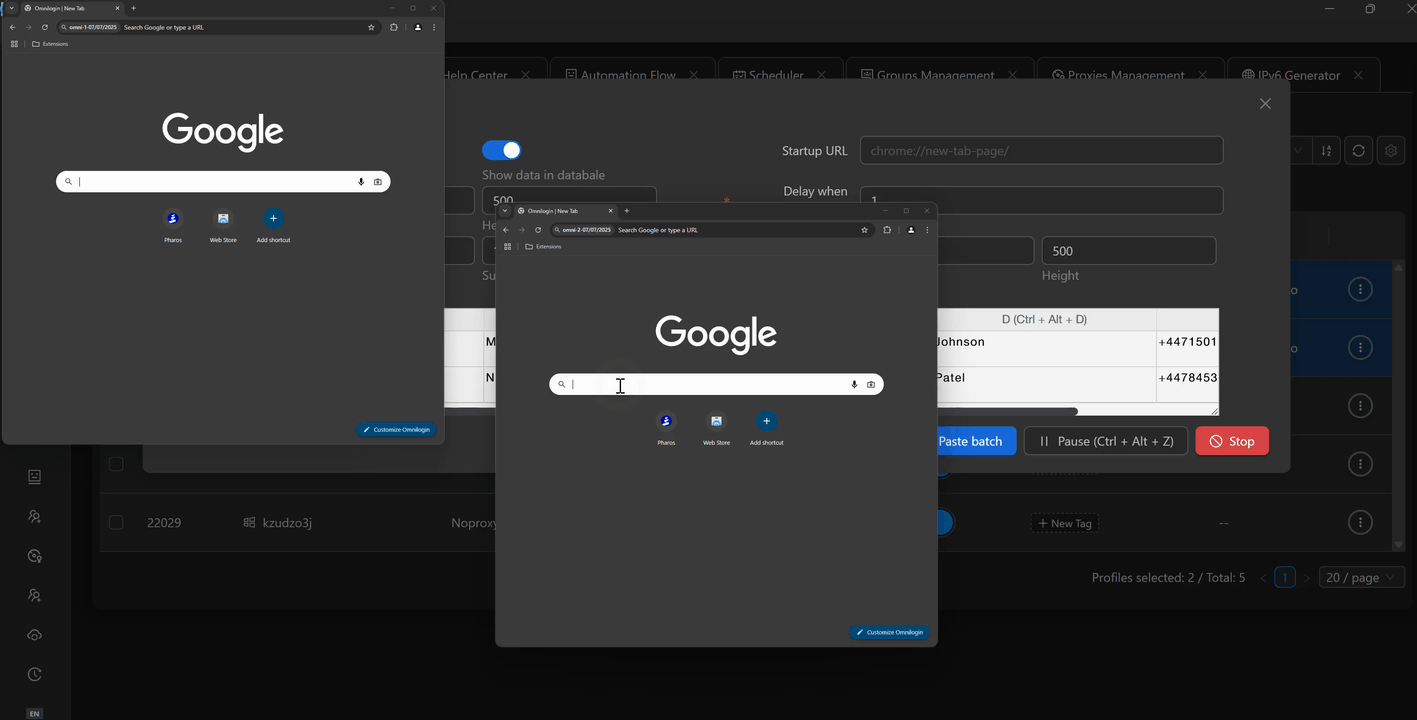
Paste Batch
Paste data sequentially to each profile.
For example, you selected this data column:

When using the Paste Batch feature, values are filled as follows:

Pause/Resume (Ctrl + Alt + Z)
Pause to manually interact with profiles or resume to continue action syncing.
Stop
Stop the action sync function.
Automated Workflow
Select profiles to run the desired script.
You can do it as shown below:

Open
Open profiles in different ways.
Quick Open
Open the selected profiles.
Open and Arrange
Open with pre-configured settings.
- Select Screen: Open profiles on the selected screens.
- Rest When Opening Profile (s): Time between opening each profile.
- Additional Parameters: Add parameters when opening profiles. Refer to parameters here.
- Customize: Customize window ratio and grid layout for columns and rows.
Close
Close profiles or selected profiles.
Arrange Windows
Arrange selected and open profiles to fit neatly within one screen.
Search
Search by profile name and tags.
Sort By
Sort by ID, name, update date, or creation date.
- Sort in ascending or descending alphabetical order.

Reload Page
If you don’t see profile updates reflecting changes, click here to reload the page.
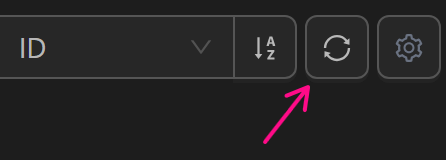
Select Display Columns on Page
Click here to choose columns to display on the page.
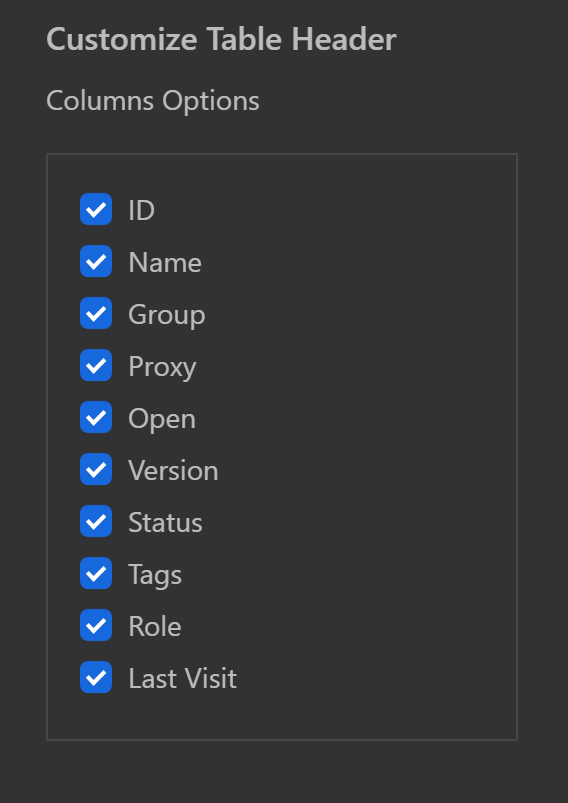
Configure Individual Profiles
At the end of a profile, click the following icon:

This allows selecting actions for that profile as follows:
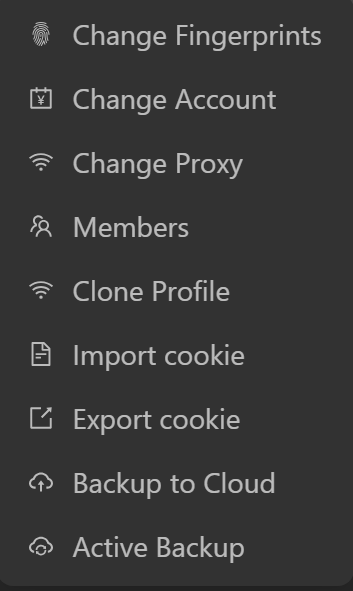
Update Fingerprints
This function allows reconfiguring some fingerprint parameters of the profile.
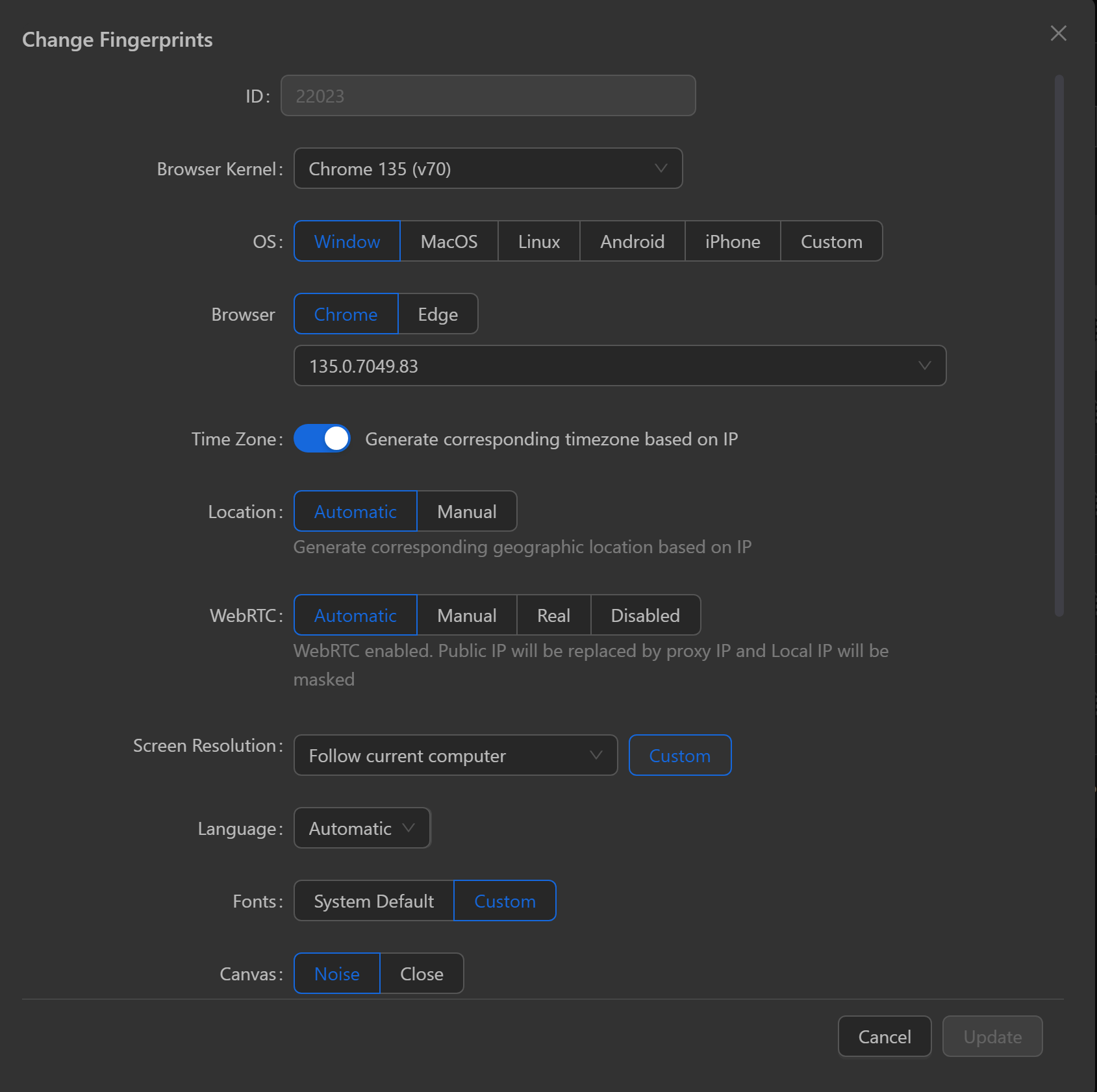
Update Account
This function allows configuring the following options:
- Automatic: The system automatically creates a folder based on your general settings.
- Manual: Manually select the Profile Data folder when launching the browser. Adjust this when using the app on multiple computers. Not recommended; use
Automaticinstead. - Notes: Notes for the profile. This data is not encrypted; avoid storing sensitive or critical information.
- URLs to Open: URLs that open when launching the profile.

Update Proxy
Update proxy for the profile, which can be done without using a proxy, configure a new proxy by clicking Custom, or select an existing proxy that has been added to Manage Proxies.
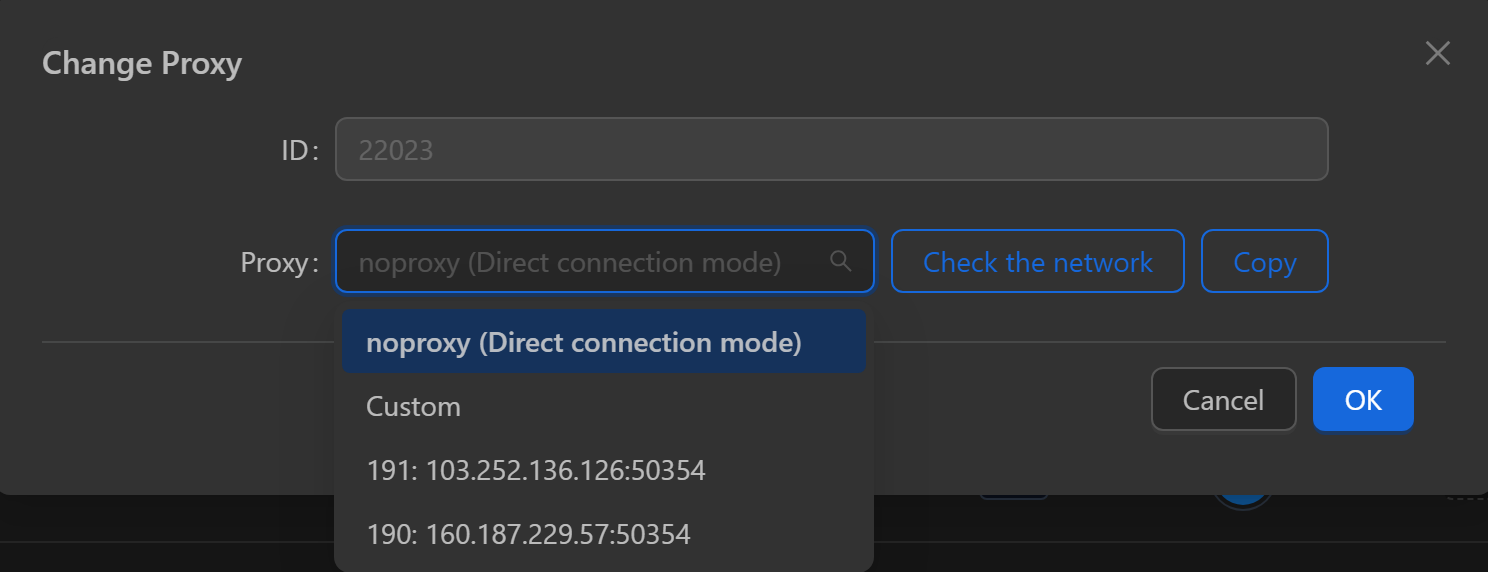

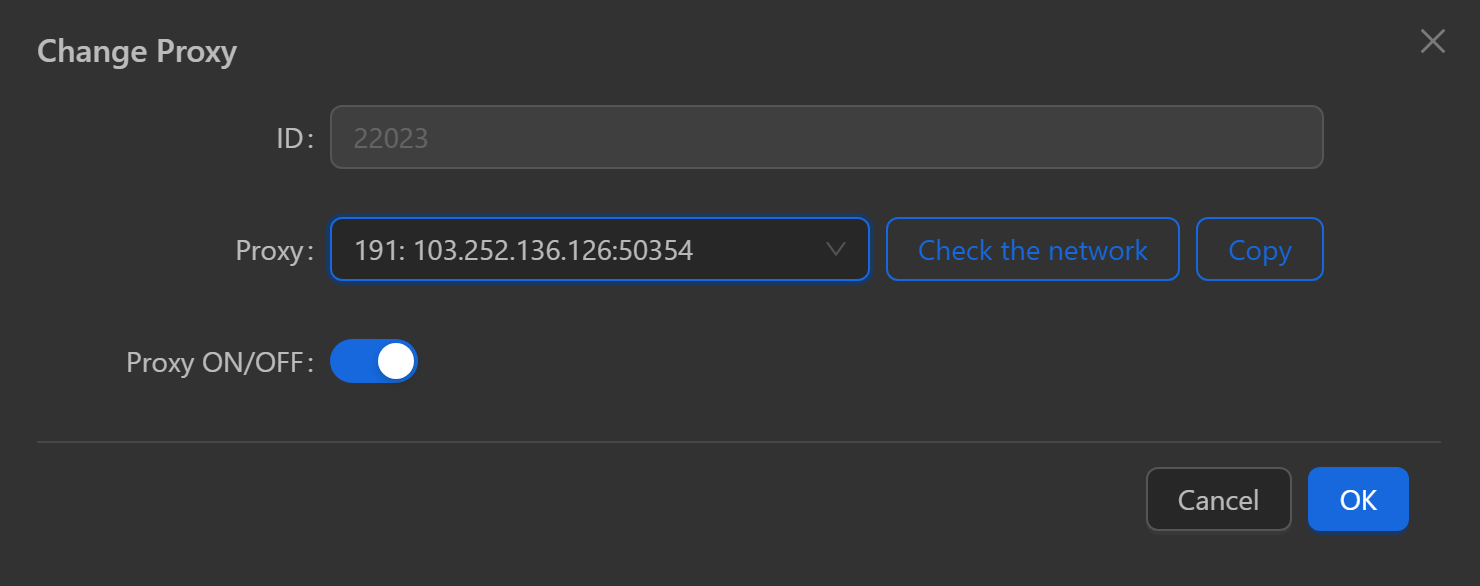
Members
Check members and their permissions for this profile.
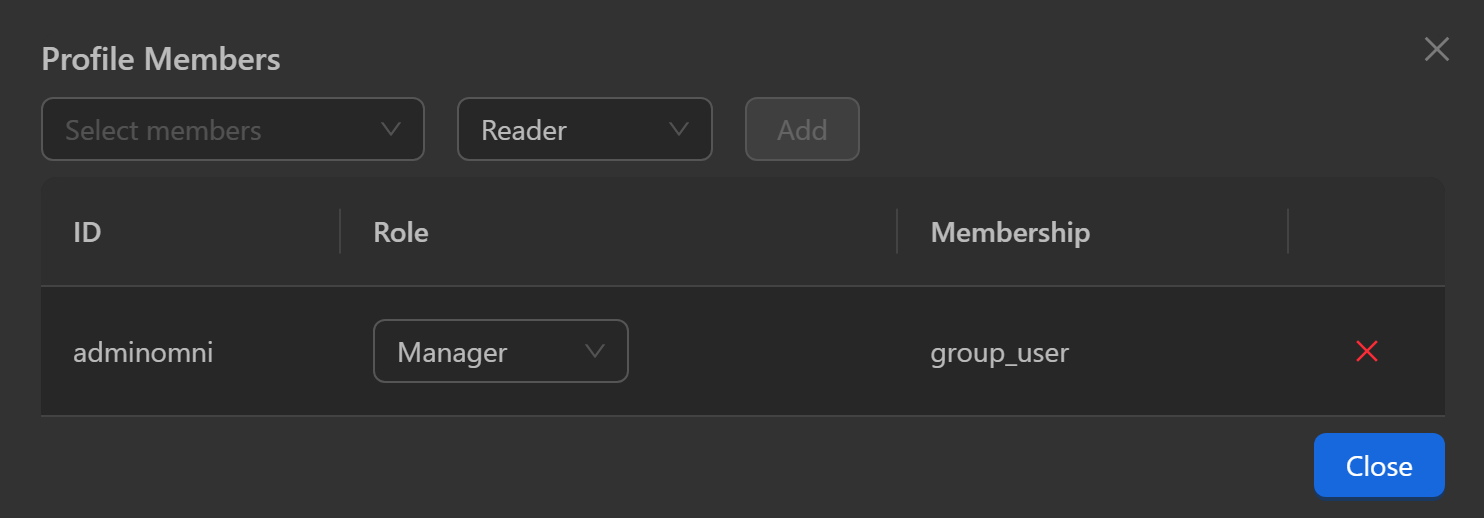
Clone Profile
Default
Clone into one profile. You can configure Profile Name, Notes, and Proxy for that profile.
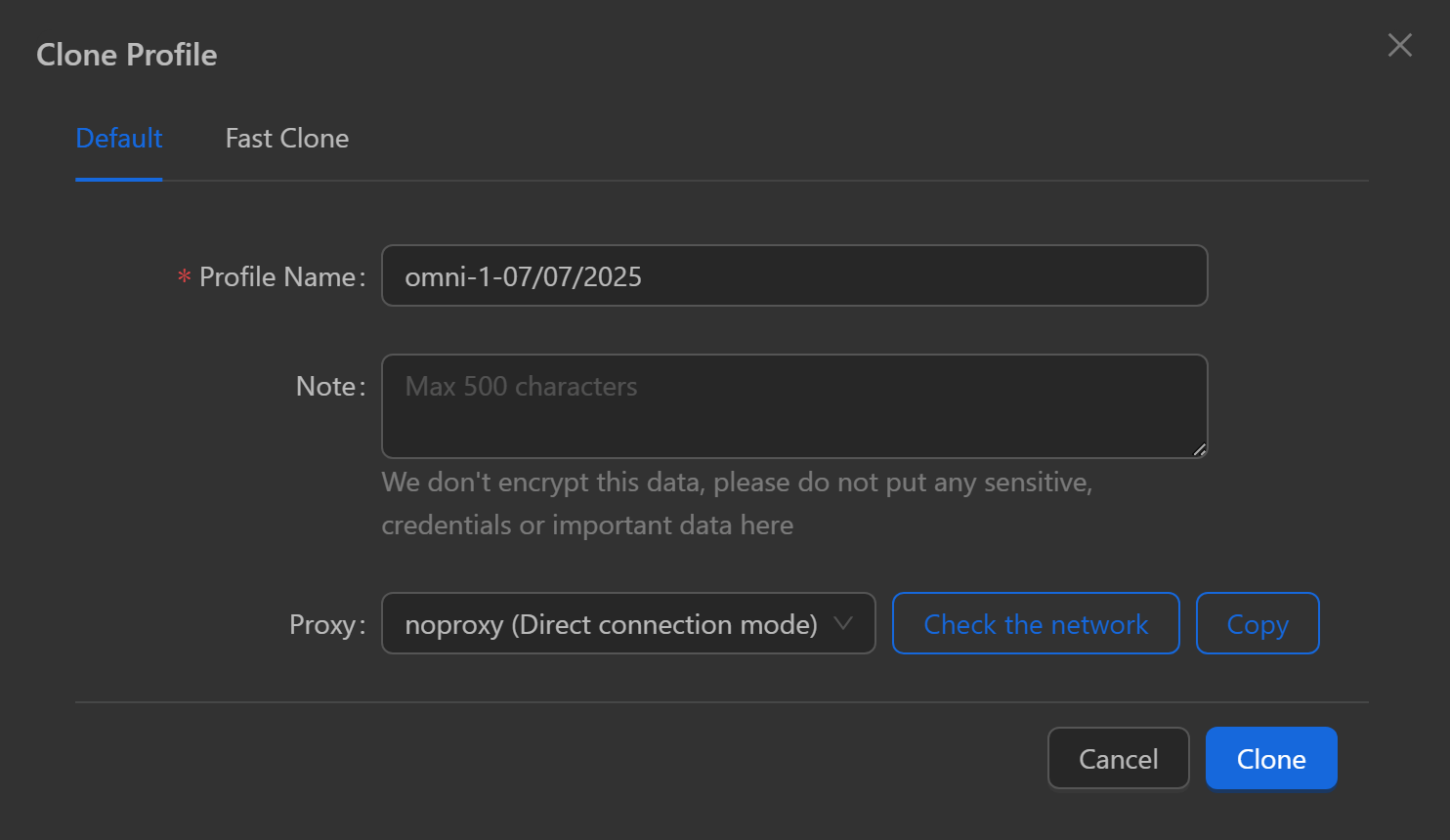
Quick Clone
Clone into multiple profiles.
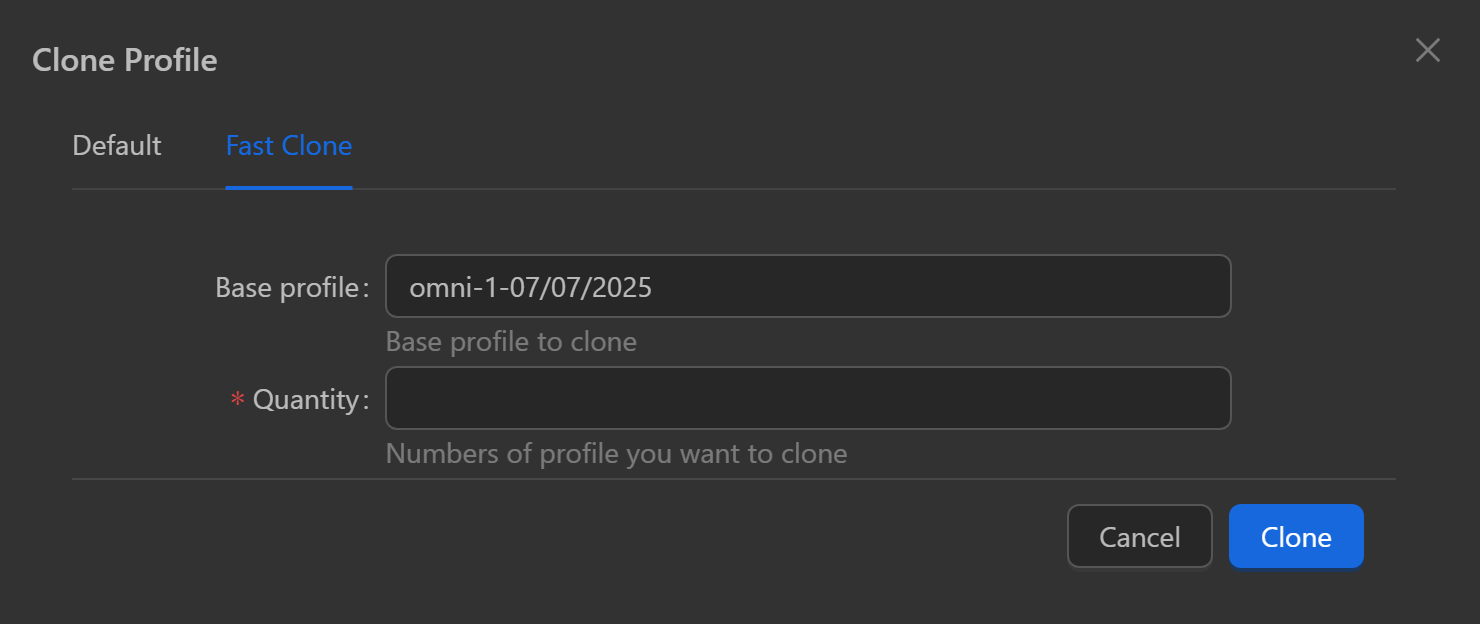
Import Cookies
Import cookies exported from an extension or from Omni in the required format.
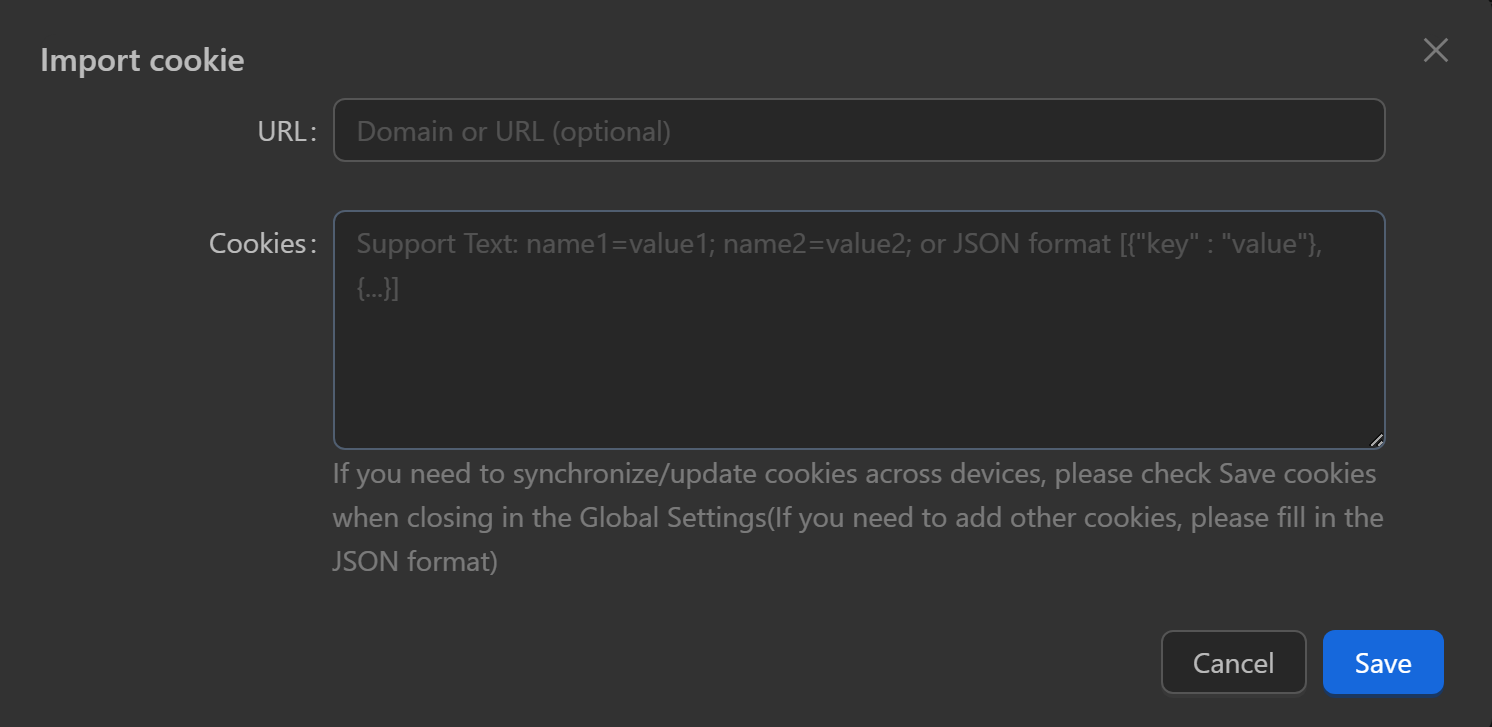
Export Cookies
Export the profile’s cookies to a file or copy to the clipboard.
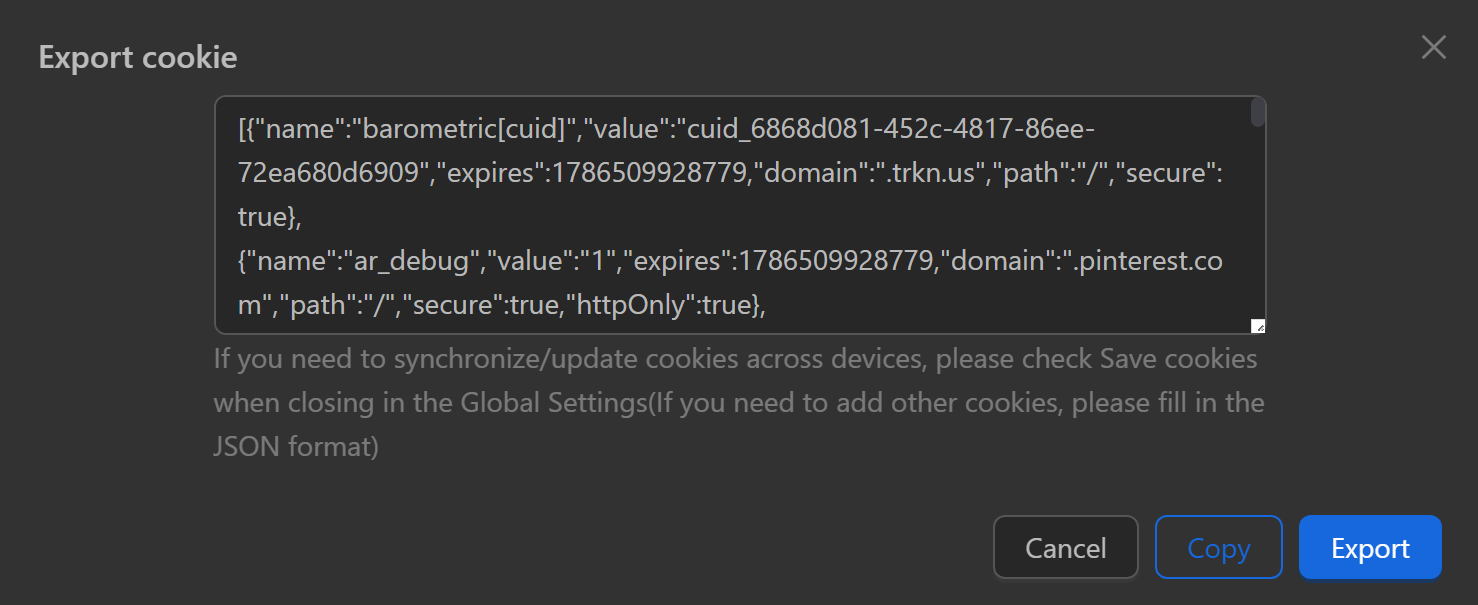
Backup to Cloud
Back up data to the cloud. The profile must have data to display this function. To use this feature, log in to the Data Sync feature.
Enable Sync
Enable data syncing for the profile. When using this profile on another computer, it will have the same data as the previous computer. However, when this feature is enabled, the profile can only be opened on one computer. To use this feature, log in to the Data Sync feature.
Update to Latest Chrome
Update to the latest downloaded Chrome version. This feature appears only if a higher Chrome version has been downloaded compared to the profile’s current version.
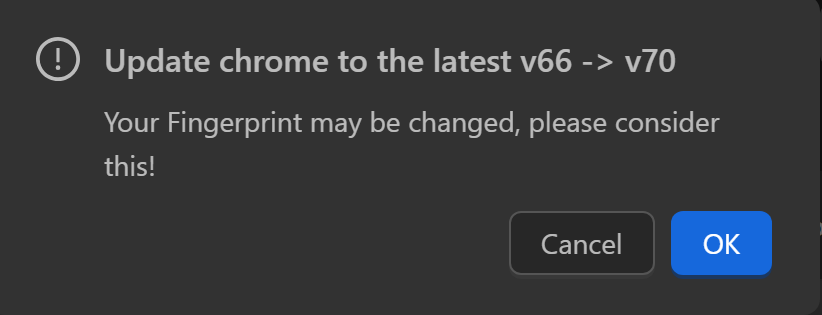
Arrange Profiles on Page
You can configure the number of profiles displayed on a page by clicking here. If the number of profiles exceeds the display limit per page, profiles will be moved to other pages.

